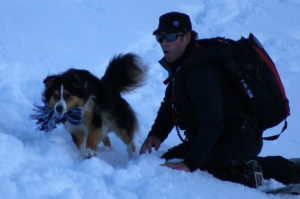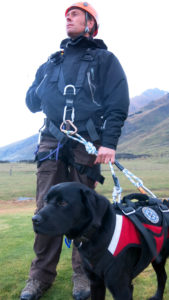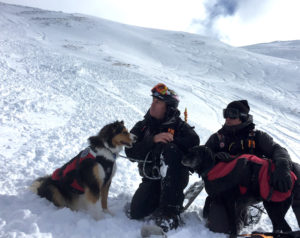-
Natural for rescue work
Some dogs are naturals at searching for people, but not all dogs (like people) are suited to search and rescue (SAR) work. A good rescue dog can’t be affected by loud or sudden sounds, and must be able to get along with other dogs and people well. To a dog SAR work is not seen as work, but as a game they love to play.

The job of an avalanche search dog is to detect human scent under snow following an avalanche. All humans constantly emit microscopic particles bearing human scent. These particles become airborne (by the millions) and can be carried by the wind for considerable distances. Dogs have a very keen sense of smell having 220 million scent receptors, (humans have 5 million) they can use this scent to locate people, something humans cannot do.
According to LandSAR NZ a highly trained avalanche dog is the equivalent to approximately 20 people on foot and can search the same area in an eighth of the time. One dog can search one hectare in approximately 30 minutes where it takes 20 people 4 hours to search the same area.
-
Personality traits and breed characteristics

Being involved in search and rescue work is a rewarding experience for a dog. It is a challenge both physically and mentally but most importantly it’s lots of fun. A dog’s personality and characteristics from its breeding are two of the most important factors in whether a dog will be suited to rescue work.
The dog needs to be intelligent, confident, focused, listen well and respond to the handler. These traits are best identified from a young age.
It is important a search dog has a high ball/play drive. Ideally a dog that is intense about playing and has a desire to play ball and fetch for a long period of time without losing focus. It doesn’t matter what breed a SAR dog is but typically they come from a sporting or herding background. Dogs that are most commonly used are German Shepherds, American Labrador Retrievers, Golden Retrievers, Bloodhounds, Border Collies, and Belgian Malinois. Mixed Breed Huskies, Poodles, Australian Shepherds, Cattle Dogs and Springer Spaniels are also used.
Physically SAR dogs can be considered in the same category as elite athletes ideally, they;
- Are physically fit
- Have an agile body
- Have good stamina
- Can adapt to hot and cold conditions
- Have no fear
- Have good balance
- Have strong legs for digging, jumping or climbing
-
Well trained
 Search and rescue (SAR) trainers prefer to train dogs from a young age. It can take up to 2-3 years to fully train a search dog so it is easier to start from when the dog is a puppy. This allows the trainer to select the right type of dog and train him to be well-rounded. Older dogs can also be trained but careful evaluation needs to be taken to make sure the dog doesn’t have any fears or problems that may inhibit it in a search and rescue role, most dogs retire by the age of 10 years.
Search and rescue (SAR) trainers prefer to train dogs from a young age. It can take up to 2-3 years to fully train a search dog so it is easier to start from when the dog is a puppy. This allows the trainer to select the right type of dog and train him to be well-rounded. Older dogs can also be trained but careful evaluation needs to be taken to make sure the dog doesn’t have any fears or problems that may inhibit it in a search and rescue role, most dogs retire by the age of 10 years.
Think your puppy could be a search dog? View the puppy aptitude test to find out
https://www.searchdogs.co.nz/wp-content/uploads/2017/03/Volhard-Puppy-Aptitude-Test.pdf
A search dog’s daily life affects their ability to do search and rescue. If a dog in training can frequently play with other dogs, kids or people whenever they want, it is unlikely they will be interested in working as they will already be getting everything they want for free.
One of the best training methods is to make SAR work all about play. Often a good start to training is by playing a form of hide and seek, where the dog is encouraged to seek out a person/toy and are rewarded in return when they find it. The dog must think it is great fun to find someone. The dogs that have that intense play drive will begin to think of SAR work as just a game with their toy at the end of it. The relationship between the handler and the dog is a crucial part of team success. The dog must be motivated to find people and work with the handler otherwise training progress will be limited.

